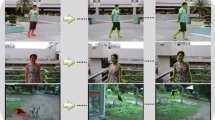Abstract
Recently, Nguyen proposed a method[1] for tracking a nonparameterized object (subject) contour in a single video stream with a moving camera and changing background. Nguyen’s approach combined outputs of two steps: creating a predicted contour and removing background edges. Nguyen’s background edge removal method of leaving many irrelevant edges is subject to inaccurate contour tracking in a complex scene. Nguyen’s method[1] of combining the predicted contour computed from the previous frame accumulates tracking error. We propose a brand-new method for tracking a nonparameterized subject contour in a single video stream with a moving camera and changing background. Our method is based on level-of-detail (LOD) Canny edge maps and graph-based routing operations on the LOD maps. We compute a predicted contour as Nguyen do. But to reduce side-effects because of irrelevant edges, we start our basic tracking using simple (strong) Canny edges generated from large image intensity gradients of an input image, called Scanny edges. Starting from Scanny edges, we get more edge pixels ranging from simple Canny edge maps untill the most detailed (weaker) Canny edge maps, called Wcanny maps. If Scanny edges are disconnected, routing between disconnected parts are planned using level-of-detail Canny edges, favoring stronger Canny edge pixels. Our accurate tracking is based on reducing effects from irrelevant edges by selecting the strongest edge pixels only, thereby relying on the current frame edge pixel as much as possible contrary to Nguyen’s approach of always combining the previous contour. Our experimental results show that this tracking approach is robust enough to handle a complex-textured scene.
Access this chapter
Tax calculation will be finalised at checkout
Purchases are for personal use only
Preview
Unable to display preview. Download preview PDF.
Similar content being viewed by others
References
Nguyen, H.T., Worring, M., van den Boomgaard, R., Smeulders, A.W.M.: Tracking nonparameterized object contours in video. IEEE Trans. Image Processing 11, 1081–1091 (2002)
Kass, M., Witkin, A., Terzopoulos, D.: Snakes: Active contour models. International Journal of Computer Vision 1, 321–331 (1987)
Peterfreund, N.: Robust tracking of position and velocity with kalman snakes. IEEE Trans. P.A.M.I. 21, 564–569 (1999)
Fu, Y., Erdem, A.T., Tekalp, A.M.: Tracking visible boundary of objects using occlusion adaptive motion snake. IEEE Trans. Image Processing 9, 2051–2060 (2000)
Paragios, N., Deriche, R.: Geodesic active contours and level sets for the detection and tracking of moving objects. IEEE Trans. P.A.M.I. 22, 266–280 (2000)
Roerdink, J.B.T.M., Meijster, A.: The watershed transform: Definition, algorithms and parallelization strategies. Fundamenta Informaticae 41, 187–228 (2000)
Nguyen, H.T., Worring, M., van den Boomgaard, R.: Watersnakes: energy-driven watershed segmentation. IEEE Trans. P.A.M.I. 25, 330–342 (2003)
Author information
Authors and Affiliations
Editor information
Editors and Affiliations
Rights and permissions
Copyright information
© 2004 Springer-Verlag Berlin Heidelberg
About this paper
Cite this paper
Park, J., Park, S. (2004). Object Boundary Edge Selection Using Level-of-Detail Canny Edges. In: Laganá, A., Gavrilova, M.L., Kumar, V., Mun, Y., Tan, C.J.K., Gervasi, O. (eds) Computational Science and Its Applications – ICCSA 2004. ICCSA 2004. Lecture Notes in Computer Science, vol 3046. Springer, Berlin, Heidelberg. https://doi.org/10.1007/978-3-540-24768-5_39
Download citation
DOI: https://doi.org/10.1007/978-3-540-24768-5_39
Publisher Name: Springer, Berlin, Heidelberg
Print ISBN: 978-3-540-22060-2
Online ISBN: 978-3-540-24768-5
eBook Packages: Springer Book Archive




